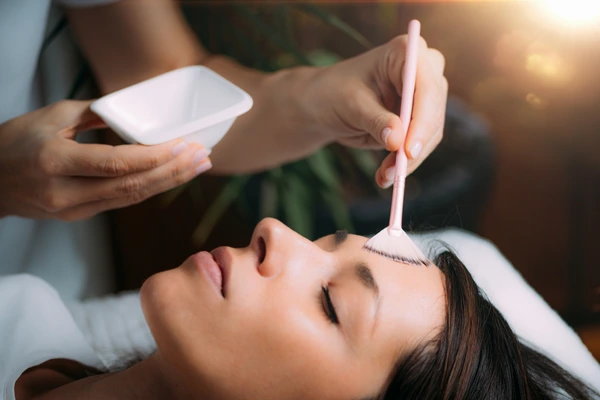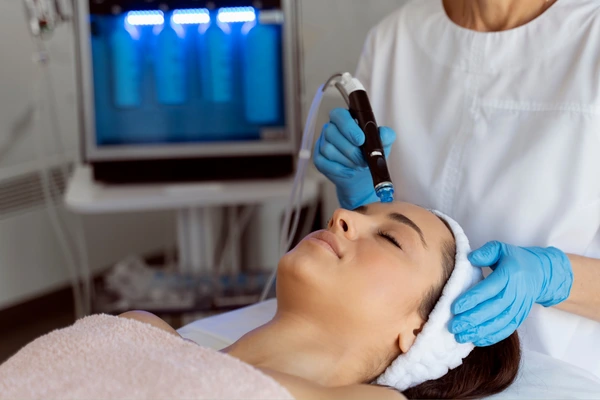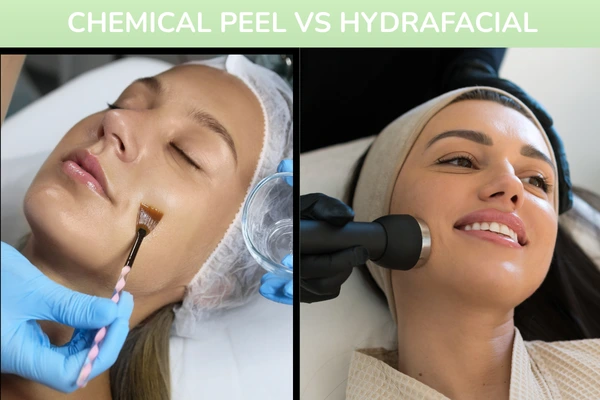Up to 25% OFF on Selected Treatments
-
Treatments
Acne and Scar
Pigmentation
Laser Hair Reduction
Dermato-surgery
Body
Anti Aging
Skin Rejuvenation
Others
- Clinics
- Blogs
Treatments
Have you ever felt bad by staring at your reflection in the mirror, noticing dullness, pigmentation, or uneven texture, and thinking about which treatment can give you healthy, glowing skin? When it comes to advanced skin care, two treatments often come up in the conversation: HydraFacial and chemical peels. As per dermatologists, both can effectively improve skin tone, texture, and overall glow, but they work in different ways. Many people visiting dermatology clinics in Bangalore ask the same question: “Chemical Peel vs HydraFacial—which is better for my skin?” With so much information available in internet, choosing the right skin care is not that easy.
HydraFacial is a non-invasive therapy designed to cleanse, resurface, and intensely hydrate your skin in one quick appointment. On the other hand, a chemical peel uses exfoliation with acids like glycolic, salicylic, or TCA to remove the damaged outer layers of skin, targeting pigmentation, sun damage, and acne.
Both treatments offer promising skin rejuvenation, but the real question remains, “Which is better, HydraFacial or chemical peel?”
The answer depends on your skin concerns, type, and tolerance for downtime. Some people prefer the instant, soothing glow of HydraFacial, while others lean towards the effective results of chemical peels. In this blog, we will break down chemical peels vs. HydraFacials, including their benefits and limitations, explain which is better, HydraFacial or chemical peel, and answer questions like, “Can I do HydraFacial after Chemical Peel for enhanced results?” so you can make the right choice.

A chemical peel is a dermatological treatment where a naturally extracted chemical solution (such as glycolic acid, salicylic acid, TCA, a phenol-based solution, or lactic acid) is applied to remove the outer damaged skin. Depending on the formulations & strength (light, medium, or deep), it removes damaged outer layers, stimulates cell turnover and improves texture, reduces acne scars, and boosts collagen production. This results in smoother skin, reduced pigmentation, and improved skin clarity.
Best for:
Treatment time: 20–30 minutes, depending on the peel strength.
Downtime: May cause redness, peeling, or mild flaking for 3–7 days (varies by peel type).
Step 1: Pre-treatment cleansing
Before starting, the skin is thoroughly cleansed to get rid of any surface oils, dirt, or makeup. This helps the chemical solution penetrate evenly.
Step 2: Solution application
A dermatologist applies a carefully selected chemical solution tailored to your skin’s needs. The choice of acid and its concentration depends on factors like skin type, concerns, and the desired level of exfoliation.
Step 3: Exfoliation process
Once applied, the solution begins to break down the bonds between dead skin cells, encouraging the top layers to shed. This controlled exfoliation process triggers cellular renewal and enhances the production of fresh skin cells.
Step 4: Peeling and renewal
Over the coming days, you may notice peeling or mild flaking as the damaged outer layer is replaced. The treatment reveals rejuvenated skin with improved clarity, smoothness, and tone.
Step 5: Recovery and post-care
After peeling, the skin might appear red or feel slightly sensitive. Following post-peel care, like avoiding sun exposure, staying hydrated, and using gentle skincare, is crucial for optimal healing and results.

The HydraFacial is a multi-step, non-invasive, advanced medical-grade facial treatment that uses patented vortex suction technology to cleanse, exfoliate, extract impurities, and infuse the skin with hydrating serums. This treatment works well on all skin types, offering immediate improvement without irritation, flaking, or downtime.
Best for:
Treatment time: 30–40 minutes.
Downtime: No, it’s often called a “lunchtime facial” because you can get back to your day immediately.
Step 1: Deep Cleansing & Exfoliation
The treatment begins with a gentle cleansing process that removes surface dirt, oil, and dead skin cells. A mild exfoliating solution is applied to open up the pores and prepare the skin for the next steps.
Step 2: Acid Peel (Mild Glycolic or Salicylic Blend)
A gentle acid solution is applied to loosen debris from the pores without causing the stinging or peeling associated with traditional chemical peels. This step helps brighten the skin and loosen deep-seated impurities.
Step 3: Vacuum Extraction
With vortex suction technology, the skin is deeply cleansed as blackheads, whiteheads, and pore impurities are cleared away without any pain. This helps unclog congested areas, particularly around the T-zone.
Step 4: Hydration & Nourishment
The skin is then infused with a blend of hydrating serums rich in antioxidants, peptides, and hyaluronic acid. Infused ingredients help plump, hydrate, and refresh the skin, resulting in a youthful, glowing appearance.
Step 5: Protection & Glow
Finally, moisturizers and broad-spectrum sunscreen are applied to protect the skin and enhance its natural radiance.

The key differences between chemical peel vs hydrafacial treatments are:
| Feature | Chemical Peel | HydraFacial |
| Procedure | Uses acids to exfoliate the skin | Uses vacuum-based vortex technology and serums |
| Target Skin Issues | Pigmentation, acne, scars, melasma and mild wrinkles | Hydration, glow, acne, clogged pores, mild anti-aging concerns |
| Pain Level | Mild to moderate | Painless and Relaxing |
| Downtime | 3-7 days, based on type of peel and formulation used | None |
| Results | Gradual, noticeable after 1-2 weeks | Immediate |
| Skin Type | Normal or oily skin | All skin types |
| Time Taken | 20-30 mins | 30-40 mins |
| Sessions Needed | 4–6 sessions for best results | Monthly maintenance recommended |
| Ideal Candidates | Pigmentation, acne scars, deeper damage, deep seated acne scars, rough spots and discoloration | Dull, dehydrated, sensitive skin, skin tone irregularities, who wish radiant skin before an important event |
| Effectiveness | Long term effects | Short term and immediate |
| Cost Factor | Less expensive than HydraFacial session | Costly than chemical peel session |
In short: If you want fast hydration and a quick glow with no downtime, go for HydraFacial. If your concern is deep skin pigmentation, scars, or deeper skin issues, a chemical peel may work better.
Many people ask us, “Which is better—HydraFacial or chemical peel for their skin type?” The truth is, there’s no single answer for this question, as it totally depends on your skin concerns:
Dermatologists often recommend combining both treatments strategically for maximum benefit. For example, a HydraFacial can prep and hydrate the skin, while a chemical peel done later targets pigmentation or scars more deeply.
One of the most common questions patients ask is, “Can I do HydraFacial after a chemical peel?”
The answer is yes, you can do HydraFacial after a chemical peel, but with medical supervision and timing.
This combination approach not only maintains hydration but also ensures faster recovery and better results.
If you are still unsure whether to choose HydraFacial vs. chemical peel, here’s a simple guide:
At Evenly Clinic, our dermatologists customize treatments based on your skin type, lifestyle, and goals, so you get results that look natural, healthy, and long-lasting.
In Bangalore, where pollution, stress, and sun exposure take a toll on skin health, patients trust Evenly Skin & Hair Clinic for advanced, dermatologist-led treatments. We use FDA-approved technologies, medical-grade peels, and authentic HydraFacial devices to ensure safe, effective, and long-lasting results. We also provide multiple skin and hair treatments such as Botox, HIFU, laser resurfacing, laser toning, dermal fillers, laser hair removal, carbon laser peel, medifacials, and many others.
Our expert dermatologists assess your skin thoroughly and design a treatment plan that may include a single treatment or a combination, depending on what your skin truly needs.
When it comes to chemical peel vs. HydraFacial, the better treatment is the one that aligns with your skin concerns, lifestyle, and desired outcomes. Remember—skincare is not about trends; it’s about science and personalization. Whether you want a quick glow or a deeper transformation, professional guidance makes all the difference.
Still not sure which treatment works better: HydraFacial or chemical peel? Book a consultation with our dermatologists at Evenly Skin & Hair Clinic, and discover if a HydraFacial after Chemical Peel or as a stand-alone treatment is right for you.
Evenly Skin and Hair Clinic – HSR Layout
Third Floor, 815, 27th Main Rd, above Bluestone, 1st Sector, HSR Layout, Bengaluru, Karnataka 560102
Evenly Skin and Hair Clinic – Jayanagar
35, Ground Floor, Vinyas Arcade, 11th Main Rd, Vishya Bank Colony, 5th Block, Jayanagar, Bengaluru, Karnataka 560041
Evenly Skin and Hair Clinic – Indira Nagar
1st Floor, 134, Above Namdhari’s Fresh, 1st Main Rd, 2nd Stage, Domlur, Indiranagar, Bengaluru, Karnataka 560071
For health-related information, follow us on Instagram!!
Is Chemical Peel better than HydraFacial for pigmentation?
Chemical peels are effective for pigmentation, melasma, and acne scars, as they penetrate deeper layers of the skin. HydraFacial is more effective for improving skin hydration, reviving dullness, and providing ongoing maintenance.
Which is better for anti-aging—HydraFacial or chemical peel?
For fine lines and wrinkles, both can help, but chemical peels offer a stronger collagen boost, whereas HydraFacial helps maintain skin hydration and elasticity. Combining both the treatments under dermatologist guidance provides the best anti-aging results.
Can I do HydraFacial after a chemical peel?
Yes, you can, but the timing matters. After a light chemical peel, you can do HydraFacial after 1–2 weeks, once peeling stops. For medium or deep peels, wait at least 4–6 weeks. Always consult a dermatologist before combining treatments.
Which treatment gives better results before a special occasion—HydraFacial or chemical peel?
HydraFacial is the go-to treatment before any special occasion for instant glow with no downtime. Chemical peels may cause redness or peeling for a few days, so they are better planned weeks before the event.
Are results from chemical peels permanent compared to HydraFacial?
No treatment offers permanent results, as our skin continues to age and get exposed to sun, pollution, and hormones. Chemical peels can give longer-lasting results compared to HydraFacial.
We hope this information is helpful. If you have any skin and hair-related questions or would like to discuss personalized solutions, please reach out to us at 7337899030. Our team of specialists is committed to delivering personalized care tailored to your specific needs. Take the first step towards a healthier, more confident you by scheduling a consultation with us today. Your journey to vibrant skin and stronger hair begins here.
Book an Appointment
Start your journey to healthy skin and hair today.
Leave a Comment